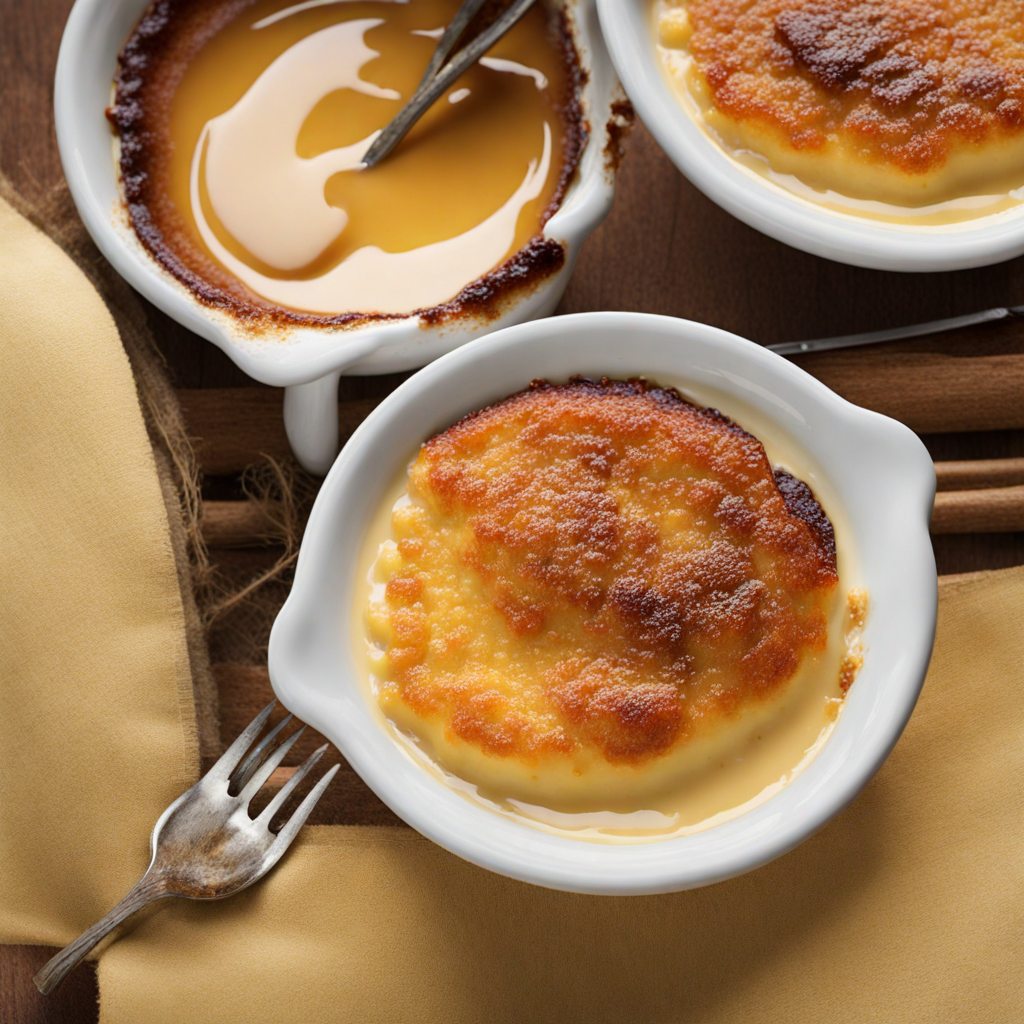Crema Catalana
Crema Catalana is a tantalizing dessert that hails from the region of Catalonia in Spain, renowned for its rich culinary heritage. This creamy custard is similar to the French crème brûlée but features a unique twist that sets it apart. Made with a base of milk and egg yolks, it is infused with fragrant flavors such as cinnamon and lemon zest, which lend a delightful aromatic quality to the dish. The creamy texture is both luxurious and smooth, making each spoonful a pleasurable experience for the palate. To finish this exquisite dessert, a layer of sugar is sprinkled on top and caramelized to create a crisp, glass-like crust. This contrasting texture adds an element of surprise; as you crack through the caramelized top, you reveal the velvety custard beneath. The interplay between the crunchy surface and the soft filling is a hallmark of Crema Catalana, inviting you to savor each bite. Traditionally served in small, shallow dishes, it is often enjoyed chilled, making it a refreshing end to any meal. Crema Catalana is not only a feast for the taste buds but also a celebration of Spanish culinary traditions. It is often enjoyed during festivals and family gatherings, embodying the warmth and hospitality of Catalan culture. Each region may have its own variations, incorporating local ingredients or unique twists, but the essence remains the same—simple, high-quality ingredients come together to create a dish that is both comforting and sophisticated, inviting you to explore the delightful world of Spanish desserts.
How It Became This Dish
Crema Catalana: A Sweet Symbol of Catalonia’s Culinary Heritage Crema Catalana, often likened to the French crème brûlée, is a beloved dessert that hails from the vibrant region of Catalonia in northeastern Spain. This rich, creamy custard topped with a crisp caramelized sugar layer is more than just a delicious treat; it represents a tapestry of cultural significance, historical evolution, and regional pride. Origins The origins of Crema Catalana can be traced back to the 18th century, although its roots may go even deeper into the culinary traditions of medieval Catalonia. The dessert is believed to have been inspired by the Roman custards and the medieval practice of sweetening dairy dishes. In fact, the earliest written references to a dish resembling Crema Catalana appear in a Catalan cookbook called "Llibre de Coch" (The Book of Cooking) by a 14th-century Catalan chef, Francesc Eiximenis. This early incarnation of the dish was known as "crema," and it was a simple custard flavored with lemon or orange zest. The name "Crema Catalana" itself became widely used in the 19th century, and by the time it gained popularity beyond the borders of Catalonia, it had evolved into a distinct dessert that characterized the region's culinary identity. The dessert is traditionally made from egg yolks, sugar, milk, and cornstarch, which are combined and cooked to create a smooth custard. What sets Crema Catalana apart from other custard desserts is its unique topping: a layer of sugar that is caramelized using a hot iron or a kitchen torch, which gives it a satisfying crunch when cracked. Cultural Significance Crema Catalana holds a special place in Catalan culture, often served during festive occasions and family gatherings. It is traditionally enjoyed on Saint Joseph's Day (La Diada de Sant Josep) on March 19th, which coincides with the feast day of Saint Joseph, the patron saint of workers and families in Catalonia. This connection to a significant cultural and religious celebration underscores the dessert's role as a symbol of Catalan identity and pride. The preparation of Crema Catalana also embodies the essence of Catalan hospitality. It is not merely a dessert but a communal experience, often made at home and shared among family and friends. The act of caramelizing the sugar on top is a moment of anticipation and excitement, as diners eagerly await the satisfying crack of the crispy layer. This interactive aspect of the dessert reinforces the bonds of community and family, making it more than just a sweet indulgence. Development Over Time As Catalonia continued to develop its culinary traditions, Crema Catalana adapted and evolved. The recipe became more refined, with various regional variations emerging. The classic version is flavored with cinnamon and lemon zest, but some modern interpretations incorporate other flavorings, such as vanilla or orange blossom. The addition of these flavors reflects the region's diverse agricultural bounty and the influence of different culinary traditions. The 20th century saw a resurgence of interest in traditional Catalan cuisine, buoyed by a broader movement across Spain to reclaim regional identities. Chefs began to experiment with traditional recipes, revitalizing classic dishes like Crema Catalana while respecting their historical roots. This culinary renaissance allowed the dessert to gain international recognition, finding its way onto menus in fine dining restaurants around the world. Moreover, Crema Catalana's popularity was further solidified by its association with Catalonia's cultural and political identity. In the wake of Spain's transition to democracy in the late 20th century, there was a renewed sense of pride in regional languages and customs. Catalan cuisine, including Crema Catalana, became a celebrated aspect of Catalan identity, representing a resistance to homogenization and a desire to preserve local traditions. Modern Interpretations In contemporary culinary practice, Crema Catalana continues to inspire chefs both in Catalonia and beyond. While the traditional recipe remains beloved, innovative chefs have sought to reinterpret the dessert for modern palates. Some have experimented with alternative milks, such as almond or coconut, catering to dietary restrictions and preferences, while others have incorporated unexpected ingredients like matcha or chocolate. The presentation of Crema Catalana has also evolved. While it was traditionally served in shallow dishes, many chefs now opt for modern plating techniques that highlight the dessert's textures and colors. This artistic approach not only elevates the dining experience but also invites a new generation to appreciate the dish's rich history. Conclusion Crema Catalana is more than just a decadent dessert; it is a reflection of Catalonia's rich culinary heritage, cultural identity, and evolving traditions. From its humble beginnings as a simple custard to its status as a symbol of Catalan pride, this delightful treat has endured the test of time, adapting to changing tastes while remaining rooted in its historical origins. As diners crack through the caramelized sugar crust and savor the smooth, creamy custard beneath, they partake in a centuries-old tradition that celebrates community, family, and the flavors of Catalonia. In every bite of Crema Catalana, one can taste not just a delicious dessert but the essence of a region steeped in history, culture, and a passion for food that continues to thrive today.
You may like
Discover local flavors from Spain







